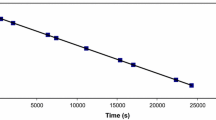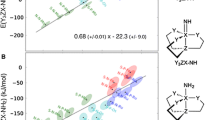Abstract
From a mechanistic consideration on the formation constant of a metal complex, the catalytic effect of a third ligandA on ligand substitution reaction is found to be given by log(k A f )=αE(A)+βH(A)+γE(A), wherek f andk A f refer to the rate constants for a non-catalyzed reaction path and catalyzed reaction path, respectively, andE andH are the electron donor constant and basicity constant of the specified ligand, respectively,α,β, andγ are constants characteristic of a metal ion and their values have been estimated from the mechanistic consideration on the reactivity of a metal ion and its complex. With this equation and the parametersα,β,γ,E, andH, the acceleration effect of halide ions on the ligand substitution reaction of mercury(II)-4-(2-pyridylazo)resorcinol complex with l,2-cyclohexanediamine-N,N,N′,N′-tetraacetic acid was quantitatively demonstrated. With the same parameters some possibilities to design a new kinetic-catalytic method of analysis based on ligand substitution reactions were proposed.
Similar content being viewed by others
References
K. B. Yatsimirskii, in:Kinetic Methods in Chemical Analysis, Pergamon, Oxford, 1966.
M. Kopanica, V. Stará, Kinetic Methods in Chemical Analysis, in:Comprehensive Analytical Chemistry, Vol. 18 (G. Svehela, ed.), Elsevier, Amsterdam, 1983.
D. P. Bendito,Analyst [London] 1984,109, 891.
S. Funahashi, M. Tabata, M. Tanaka,Bull. Chem. Soc. Jpn. 1971,44, 1586.
S. Funahashi, M. Tabata, M. Tanaka,Anal. Chim. Acta 1971,57, 311.
M. Tanaka,J. Inorg. Nucl. Chem. 1973,35, 965;1974,36, 151.
R. M. Fuoss,J. Am. Chem. Soc. 1958,80, 5059.
S. Yamada, M. Tanaka,J. Inorg. Nucl. Chem. 1975,37, 587.
R. G. Pearson,J. Am. Chem. Soc. 1963,85, 3533.
M. Tanaka, S. Yamada,J. Chem. Soc. Chem. Commun. 1976, 178.
S. Yamada, T. Kido, M. Tanaka,Inorg. Chem. 1984,23, 2990.
S. Yamada, K. Ohsumi, M. Tanaka,Inorg. Chem. 1978,17, 2790.
S. Yamada, M. Tanaka,Bull. Chem. Soc. Jpn. 1985,58, 2234.
S. Yamada, I. Yamauchi, A. Murata (in preparation).
M. Tabata, S. Funahashi, M. Tanaka,Anal. Chim. Acta 1972,62, 289.
Author information
Authors and Affiliations
Rights and permissions
About this article
Cite this article
ámada, S., Murata, A. & Tanaka, M. How to design a kinetic-catalytic method of analysis based on ligand substitution reactions. Mikrochim Acta 96, 291–297 (1988). https://doi.org/10.1007/BF01236113
Received:
Issue Date:
DOI: https://doi.org/10.1007/BF01236113




